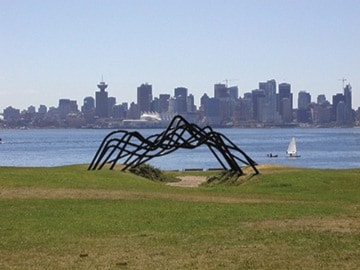Terry Farrell
Record staff
The Comox Valley Art Gallery hosted an open discussion on the topic of public art at the recent “Voices of Fire,” with voices of experience on the panel.
Karen Henry, public art director for the City of Vancouver, was one of the feature speakers on the panel.
Bill Porteus, a Victoria-based artist who helped implement the capital city’s public art policy, and local artist Ed Varney were also on the panel.
The purpose of the discussion was to shed light on the benefits of public art, what other cities are doing to support public art, and how Courtenay can improve on its support and promotion of public art.
“We were just trying to get a bit of a dialogue going around whether we should be looking at ways to have more public art enrich the cultural environment of the city,” said CVAG executive director Glen Sanford, who was part of the Voices of Fire organizing committee. “Cities like Vancouver, most of its parks and a lot of its places have examples of public art, but here in Courtenay, we have almost none, which is unusual. Even on the Island, cities like Duncan and Nanaimo - they actually have policies in place that we don’t have here.”
It’s not for a lack of local talent to promote. The Comox Valley is rife with artists, covering most every style of art. From Cumberland to Comox, to Denman and Hornby islands, the community is nationally renown for its artistic strength.
Yet, when it comes to promoting from within, the community is lagging.
“One example, Douglas Senft, who passed away a couple of years ago – his work is displayed as public art in other cities around the country, but none of it is here,” said Sanford. “He (lived) here [in Royston], and is known across the country for producing these big sculptures.”
Vancouver has a public art policy in place that includes working with developers, so that a certain portion of their construction budget is specifically earmarked for public art.
Build a condominium complex; donate public art to the city.
“That is part of our program,” said Henry. “In the case of rezoning, when a developer is getting some benefit, by being allowed more density, or what have you, then that will figure in to a number of things in the city of Vancouver, and one of them is public art.”
While such a plan would not be as successful in the Comox Valley, due to the relative lack of commercial development in the area, it is a policy that can easily be implemented – at little cost to the city, and for the benefit of the entire community. But even in Vancouver, the city contributes to the cultural enrichment in other ways.
“The rezoning program is not the only part of the public art program,” said Henry. “The city does contribute part of the capital budget toward public art.”
She added that there are many reasons to champion public art.
“Public art is one of those things that has many different benefits,” she said. “It reflects the communities and the spirits of people that live in the area, and it can also give the area an identity. So it becomes both part of how the city develops and how we identify and express the city, as well as how other people identify the city.”
Henry said developing such a public art policy is not anything that will happen overnight. It is a process, and it’s not only the City’s responsibility. There has to be an interest expressed by the masses in developing such a program.
“You have to have a city that has a commitment and a certain amount of resources, and you have to have a public interest in that.”
editor@comoxvalleyrecord.com
